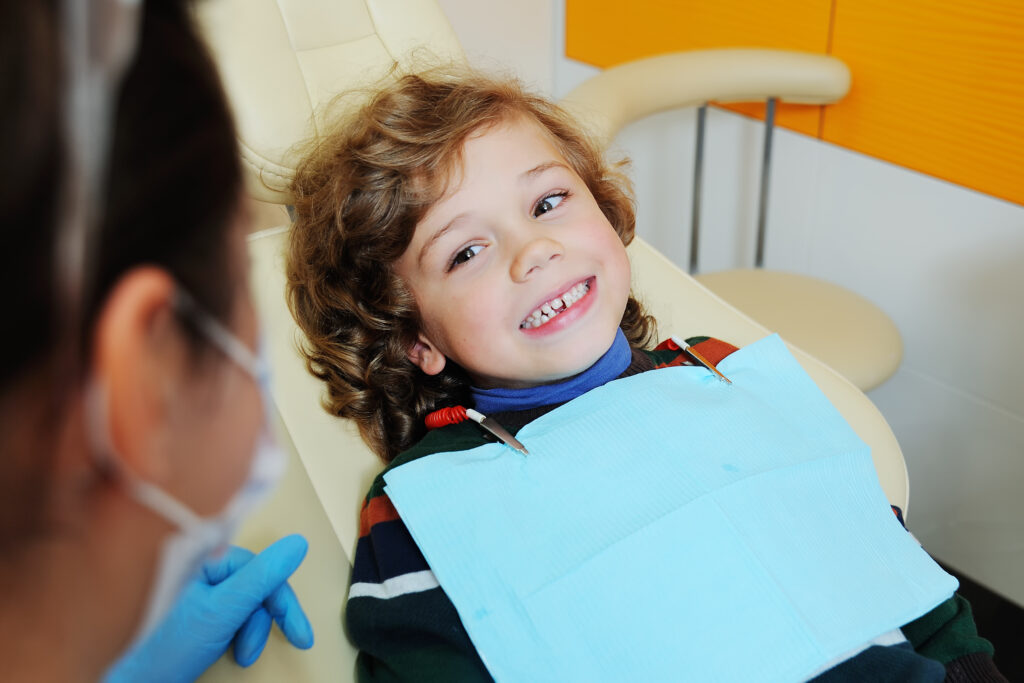
What to Expect When Your Child Gets Braces
A guide on the process and expectations during the first orthodontic visit for children.
- Initial consultation insights
- Preparing for braces
- FAQs for new patients
- First week with braces
Child orthodontics focuses on diagnosing and treating dental and jaw irregularities early, ensuring proper development.
Child orthodontics represents a specialized branch of dental care focused on guiding the development of young teeth and jaws during critical growth years. This preventive and corrective approach builds the groundwork for a healthy, confident smile that can last a lifetime. Addressing orthodontic issues early in childhood can prevent more serious dental problems from developing later, making early intervention a cornerstone of pediatric dental health. By identifying and treating alignment concerns during the formative years, orthodontists can guide jaw growth, create adequate space for incoming permanent teeth, and potentially eliminate the need for more complex and invasive treatments in adulthood.
Child orthodontics is a specialized branch of dentistry focused on diagnosing, preventing, and treating dental and jaw irregularities in children, typically starting evaluations by age 7 to address issues early and promote optimal oral health. Early orthodontic care is crucial because it can intercept and correct developing problems before they become severe, potentially reducing treatment complexity and duration later.
Orthodontics is a specialty within dentistry focused on diagnosing, preventing, and treating alignment issues involving the teeth and jaws. In the pediatric context, this discipline takes on particular importance because children's dental structures are still developing. Child orthodontics employs gentle, personalized approaches that work with the natural growth patterns of young patients to guide teeth and jaws into proper alignment. Every orthodontic plan is tailored to each child's unique needs, taking into account their age, growth stage, and individual treatment goals.
Early orthodontic evaluation serves as a critical foundation for successful long-term dental health. The American Association of Orthodontists recommends that children complete their first check-up with an orthodontist by age 7. At this pivotal age, children have a mix of baby (primary) and permanent teeth, which provides orthodontists with valuable information about how their dental development is progressing. Examining this mix of teeth allows the orthodontist to recognize orthodontic problems in their earliest stages, even before they become apparent to parents or the child.
This early evaluation accomplishes several important objectives. It allows orthodontists to assess growth patterns, tooth eruption timing, and bite function to determine the best timing and approach for any necessary treatment. If problems are identified, the orthodontist can advise on recommended treatments, when they should begin, and their expected duration. While children may be evaluated at age seven, this assessment primarily focuses on monitoring how the mouth, jaw, and teeth are developing rather than beginning full treatment immediately. Most children do not receive braces at age seven; instead, early correction of specific orthodontic issues creates the foundation for braces treatment to begin at the ideal time, typically between ages 9 and 16.
The primary goal of child orthodontics is to address alignment problems while the child's oral structures are still developing and more responsive to treatment. Early intervention can guide jaw growth and create room for incoming permanent teeth, potentially preventing more complex treatment later on. Common concerns that child orthodontists address include crowding, spacing, crossbite, overbite, underbite, and protruding front teeth. By treating these issues early, orthodontists can often prevent the need for tooth extractions or more invasive procedures later in life.
Beyond simply straightening teeth, correcting dental issues early supports proper bite function and jaw alignment. This prevents complications such as jaw shifting or clicking, which can lead to jaw pain and other dental consequences. Additionally, addressing cheek biting—a condition that occurs when upper and lower teeth don't fit together properly—protects children from self-inflicted oral tissue damage during normal chewing.
Child orthodontics is vital for preventing complex dental issues.
Early treatment supports healthy development and confidence.

Orthodontic treatment contributes significantly to improved facial aesthetics and proportions. When teeth and jaws are properly aligned, the overall facial structure appears more balanced and harmonious. This aesthetic improvement has profound effects on children's self-confidence and social development. A confident smile gained through orthodontic treatment can positively influence how children interact with their peers, participate in social activities, and develop their self-image during these formative years. The psychological benefits of achieving a healthy, attractive smile often extend far beyond the dental realm, supporting overall emotional well-being and social integration.
Traditional metal braces remain one of the most reliable and effective solutions for complex dental issues in children, including misaligned bites and crowded teeth. Braces consist of brackets that are affixed to teeth and wires that are threaded through slots in the brackets. Modern braces have evolved significantly, now featuring smaller, more comfortable brackets than their predecessors. Many pediatric practices offer colorful bands that allow children to personalize their orthodontic experience by choosing colors that match their favorite sports teams, holidays, or moods, making treatment feel more fun and age-appropriate. This customization aspect helps children feel more invested in their treatment journey.
Ceramic braces offer an alternative to traditional metal braces, providing a more aesthetically subtle option while maintaining the effectiveness of conventional braces technology. The choice between metal and ceramic braces depends on factors such as the complexity of the case, the child's age and maturity level, and family preferences regarding appearance during treatment.
Clear aligners represent a modern alternative to traditional braces for certain cases. These aligners are composed of clear, thin, plastic-like trays that are formed to fit an individual's teeth. Patients are responsible for inserting and removing them, which requires a level of responsibility and compliance. Invisalign for kids represents a specialized version of this technology designed for younger patients. Clear aligners offer aesthetic advantages since they are nearly invisible when worn, which appeals to many children and adolescents who may feel self-conscious about visible orthodontic appliances. However, aligners work best for mild to moderate alignment issues and require significant patient compliance, making them more suitable for older children and teenagers who can reliably follow wearing schedules.
Beyond braces and aligners, orthodontists may employ additional therapies to support healthy development. Palatal expanders gently widen the upper arch to create space, improve airflow, and support proper bite relationships during growth. These devices are often used in early intervention phases to address specific developmental concerns before full braces treatment begins. Retainers are essential components of any orthodontic treatment plan, as they hold teeth in their new positions while the surrounding bone and soft tissues stabilize after active treatment concludes.
Tooth misalignment, or malocclusion, represents one of the most common orthodontic concerns in children. Various factors contribute to crowding and spacing issues, including genetics, early loss of baby teeth, and harmful habits such as thumb-sucking or prolonged pacifier use. Crowding occurs when there is insufficient space in the jaw for all teeth to align properly, while spacing refers to gaps between teeth. Early identification and treatment of misalignment can guide the eruption of permanent teeth into more favorable positions, often reducing the severity of crowding and potentially eliminating the need for tooth extractions. Addressing protruding front teeth early also prevents potential trauma injuries to these vulnerable teeth.
Bite problems, or malocclusions involving the relationship between upper and lower teeth, require careful orthodontic management. An overbite occurs when the upper front teeth overlap significantly with the lower front teeth, while an underbite represents the opposite condition where lower teeth protrude beyond upper teeth. Crossbites occur when some upper teeth bite inside the lower teeth rather than outside. These bite problems can result in improper chewing function, speech difficulties, and long-term jaw joint problems if left untreated.
Orthodontists are experts in evaluating how teeth come together and can ensure children's jaws are aligned correctly. Proper bite alignment is crucial for optimal chewing function, speech development, and prevention of future jaw complications. Early intervention can often correct these bite issues more easily during childhood when the jaw is still developing and more responsive to corrective forces.
While evaluation typically occurs by age seven, the actual treatment phase varies significantly on a case-by-case basis. Establishing a relationship with an orthodontic team early allows professionals to monitor oral development and recommend treatment at the proper time. Most comprehensive braces treatment for children does not begin until between ages 9 and 16, after the majority of permanent teeth have erupted. Some children may benefit from limited early intervention orthodontics focused on addressing specific developmental issues before full treatment begins. This staged approach optimizes outcomes by working in harmony with the child's natural growth and development patterns.
Parents play a crucial role in preparing their children for orthodontic treatment. Emphasizing the importance of maintaining good oral hygiene with braces is essential, and parents should demonstrate proper brushing and flossing techniques to keep teeth and braces clean. Children should be prepared for dietary changes, learning which foods to avoid—such as sticky or hard items that can damage braces—while exploring suitable alternatives. Encouraging children to ask questions and express concerns helps reduce anxiety, and reassuring them that the orthodontic team will support them throughout the process creates a positive treatment experience.
Child orthodontics represents a vital investment in long-term oral health and well-being. By seeking timely orthodontic evaluations for children by age seven, parents can identify potential issues early and work with orthodontic professionals to develop comprehensive treatment plans. The combination of early detection, personalized treatment approaches, and modern orthodontic technologies allows practitioners to guide healthy dental development while minimizing the need for complex procedures later in life. Beyond the physical benefits of proper alignment, orthodontic treatment during childhood contributes to enhanced self-esteem, improved social confidence, and the foundation for a lifetime of healthy, beautiful smiles. Parents concerned about their child's dental development should not hesitate to schedule an initial orthodontic consultation, as early intervention often proves more effective and efficient than waiting until problems become more severe.
We collaborate with leading orthodontic experts to provide quality care.




A guide on the process and expectations during the first orthodontic visit for children.

Explore how early orthodontic care can influence long-term dental health.
Discover the latest advancements that are transforming orthodontic care for children.
Understanding the importance of early assessments for dental corrections.
Debunking myths that prevent parents from seeking timely orthodontic care for their children.